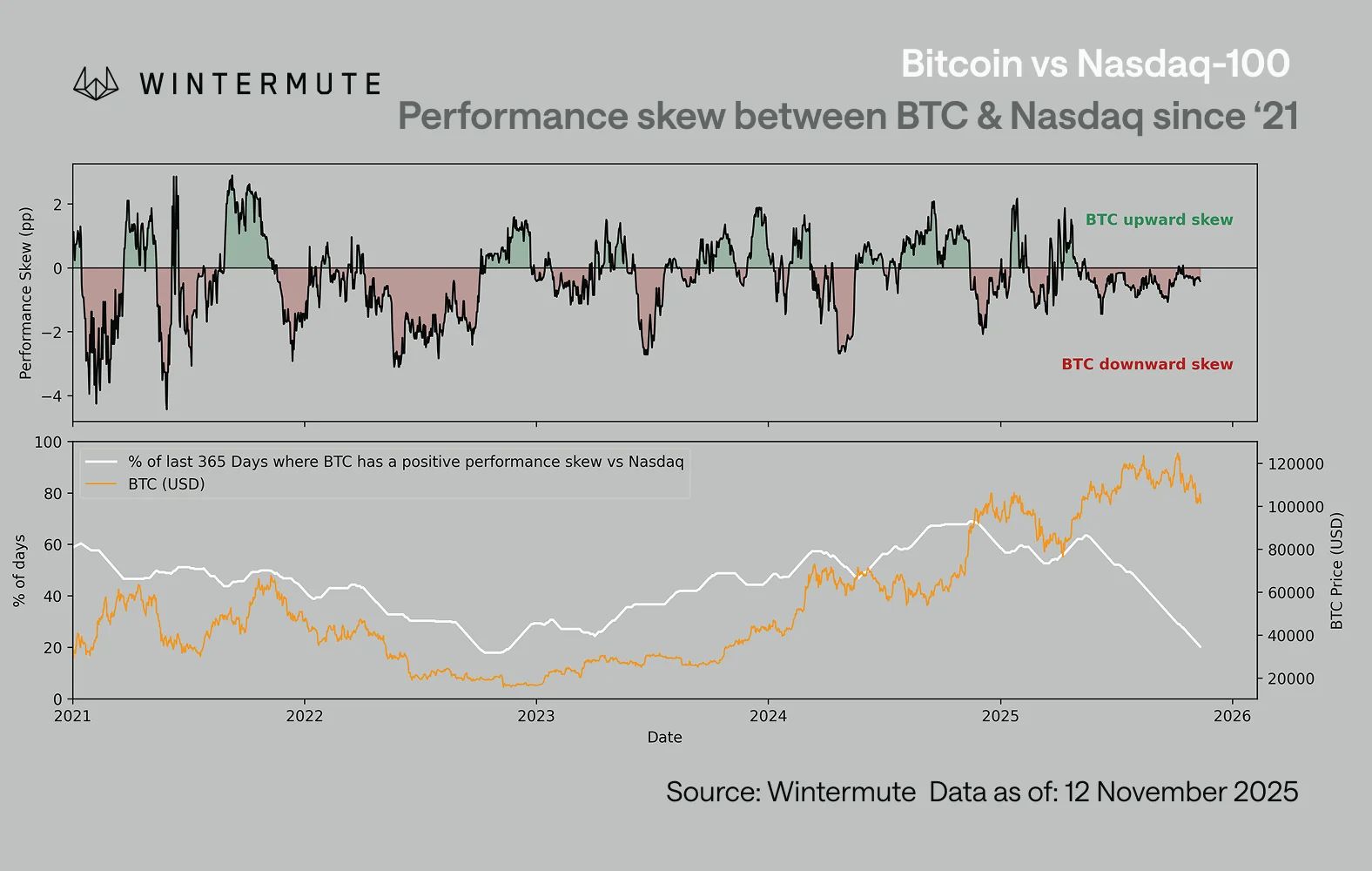Bitcoin Falls Harder Than Tech as Nasdaq Link Tightens and Skew Turns Negative
Bitcoin’s correlation with the Nasdaq has surged while its relationship with gold has nearly vanished, pushing the asset deeper into tech-stock territory. Analysts warn that thin liquidity and bearish skew now define its market behavior.
Bitcoin’s 30-day correlation with the Nasdaq 100 Index has surged to its highest level in 3 years. Meanwhile, its link to traditional safe-haven assets, such as gold, has dropped to nearly zero.
This significant shift raises questions about Bitcoin’s digital gold narrative as it now acts more like a high-beta technology asset than a stable store of value.
Bitcoin Mirrors Tech Stock Volatility as Market Dynamics Shift
In a recent post on X (formerly Twitter), The Kobeissi Letter highlighted that the cryptocurrency’s 30-day correlation with the Nasdaq 100 Index has reached roughly 0.80. This was the highest reading since 2022 and the second-strongest level in the past decade.
Bitcoin’s correlation with equities turned positive in 2020. Over the last five years, the largest cryptocurrency has generally moved in the same direction as the tech-heavy index. It only broke that pattern for short stretches in 2023.
This long-running trend has now pushed Bitcoin’s five-year correlation with the Nasdaq to 0.54. Meanwhile, The Kobeissi Letter noted that Bitcoin shows almost no statistical relationship with assets traditionally viewed as safe havens, including gold.
“Bitcoin is increasingly behaving like a leveraged tech stock,” the post read.
Furthermore, in its latest report, Wintermute pointed to a more pressing dynamic: the quality of the correlation has shifted. The firm explained that while the directional correlation with the Nasdaq remains elevated, its quality has deteriorated into a bearish skew. This means that,
- When equities fall, BTC falls harder.
- When equities rise, BTC participates weakly.
“Right now, that skew is firmly negative, showing that BTC still trades as a high-beta expression of risk sentiment, but only when it cuts the wrong way,” the analysis reveals.
 Bitcoin and Nasdaq Correlation. Source:
Wintermute
Bitcoin and Nasdaq Correlation. Source:
Wintermute
Notably, the “pain gap,” has surged to levels not seen since late 2022. This results in a structural performance disadvantage, where Bitcoin underperforms in risk-on environments—characterized by investor optimism—and overreacts in risk-off scenarios, amplifying downside moves.
Wintermute’s Jasper De Maere revealed that two forces explain why this skew is appearing now. First, investor mindshare has shifted toward equities, especially mega-cap tech. It has absorbed most of the risk-on flows that previously rotated into crypto.
“This crowding of mindshare means BTC remains correlated when global risk sentiment turns, but doesn’t benefit proportionally when optimism returns. It reacts as a ‘high-beta tail’ of macro risk rather than a standalone narrative, the downside beta remains, the upside narrative premium does not,” De Maere stated.
Second, structural liquidity in crypto remains thin. Stablecoin supply has stalled, ETF inflows have slowed, and exchange depth has not recovered to early-2024 levels. This fragile liquidity amplifies downside moves, reinforcing the negative skew.
“Historically, this kind of negative asymmetry doesn’t appear near tops but rather shows up near bottoms. When BTC falls harder on bad equity days than it rises on good ones, it usually signals exhaustion, not strength,” the report added.
Market data further corroborates this. Over the past 41 days, the crypto sector has shed $1.1 trillion in market capitalization, equating to $27 billion daily. Bitcoin itself has dropped 25% in the last month, moving below $95,000 amid a broader sell-off.
“US stock market futures just opened and they are completely unfazed by the crypto decline this weekend. Even as crypto has lost -$100 billion since Friday, US stock market futures are GREEN,” The Kobeissi Letter reported.
Furthermore, gold has surpassed $4,100 per ounce, outperforming Bitcoin by 25 percentage points since early October. According to The Kobeissi Letter,
“The isolated nature of the -25% crypto downturn further supports our view: This is a leverage and liquidation-based crypto ‘bear market.'”
Taken together, these developments raise a crucial question for investors: can Bitcoin still be viewed as a safe-haven asset? With correlations elevated, liquidity thin, and downside reactions outweighing upside participation, the current data points to a market where Bitcoin behaves more like a high-beta speculative asset than a defensive hedge.
Whether this dynamic proves temporary or structural will depend on how risk sentiment, liquidity conditions, and investor positioning evolve in the months ahead.
Disclaimer: The content of this article solely reflects the author's opinion and does not represent the platform in any capacity. This article is not intended to serve as a reference for making investment decisions.
You may also like
Bitcoin Updates: MicroStrategy's Bold Bitcoin Investment Stands Strong Despite 57% Drop in Stock Value
- MicroStrategy's CEO reaffirms Bitcoin buying strategy amid market volatility, adding 8,178 BTC for $835.6M. - Despite 57% stock decline, MSTR's Bitcoin holdings reach $61.7B, funded by preferred shares and convertible notes. - Critics question debt-driven model's sustainability, but analysts praise its Bitcoin-per-share growth and $535 price target. - Saylor envisions $1T Bitcoin balance sheet, leveraging appreciation for credit products and reshaping global finance.
Ethereum Updates Today: Buddy Goes All-In on ETH with $13 Million Leveraged Wager Amid Market Slump
- Buddy Huang’s ETH long position was liquidated, prompting a $9.5M reentry amid market turmoil. - Market selloff attributed to macroeconomic pressures, with BTC dropping 28.7% below $90K. - A $1.24B ETH whale added 13,117 ETH despite $1.59M unrealized losses, signaling bullish conviction. - Institutional caution grew as SoftBank exited $5.8B NVIDIA stake, while Coinbase hinted at December 17th product launch. - Buddy’s $13M leveraged bet faces liquidation risk if ETH fails to stabilize above $3,000, highl

The Rapid Drop in COAI Shares: Red Flag or Investment Chance?
- COAI Index fell 88% YTD in Nov 2025, sparking debate over systemic collapse vs undervalued opportunity. - Market sentiment diverges from fundamentals: C3.ai shows 26% YoY revenue growth despite governance crises and $116M Q1 loss. - CLARITY Act regulatory uncertainty, leadership turmoil at C3.ai, and crypto frauds like Myanmar's $10B scam fueled sector-wide selloff. - C3.ai's $724M cash reserves and 69% gross margin highlight resilience, but legal battles and regulatory ambiguity persist as key risks. -

DappRadar's Shutdown Reflects Challenges Faced by the Industry Amid Market Volatility
- Web3 analytics firm DappRadar announced its shutdown due to "financially unsustainable market conditions," causing its RADAR token to drop 30%. - Companies like PG Electroplast and GEM Aromatics reported revenue declines amid U.S. tariffs, GST changes, and raw material costs, reflecting broader economic challenges. - Geox cut 2025 sales forecasts by high single digits after 6.2% year-to-date revenue fall, while cost cuts helped stabilize its EBIT margin. - Tech stocks face volatility: Nvidia downgraded a

